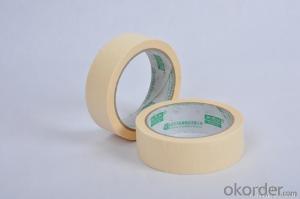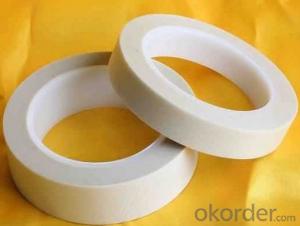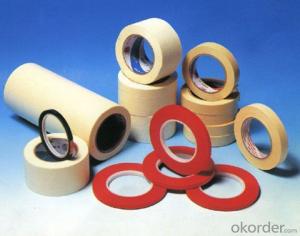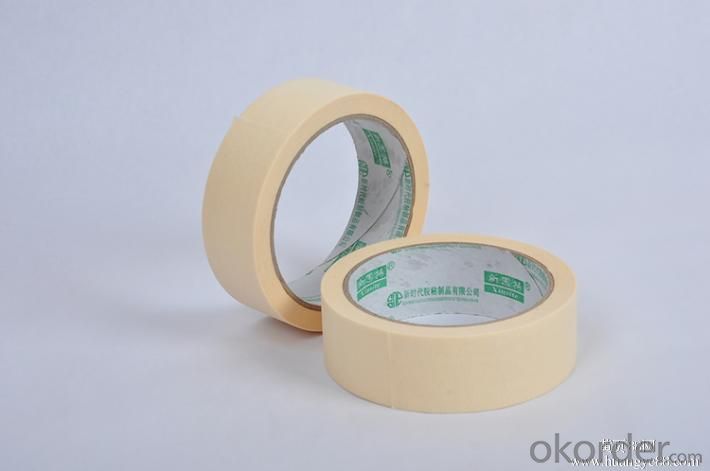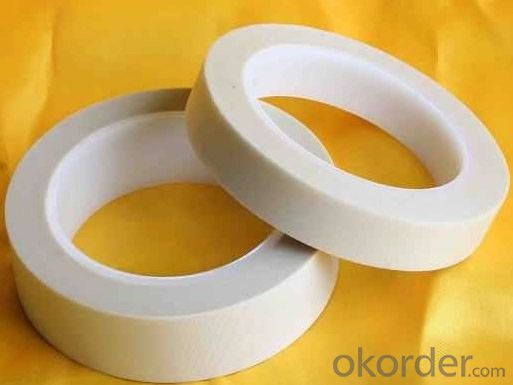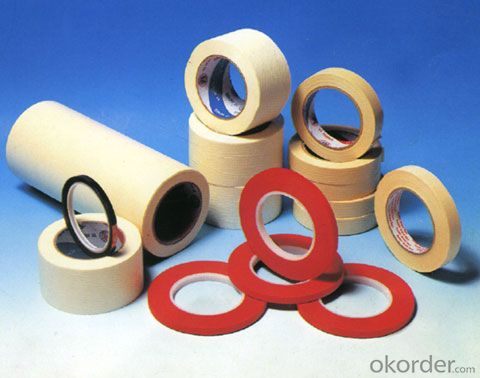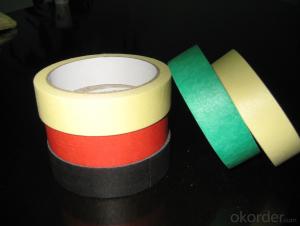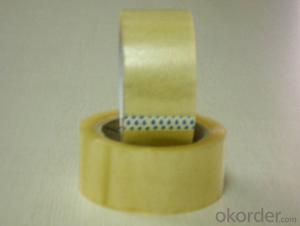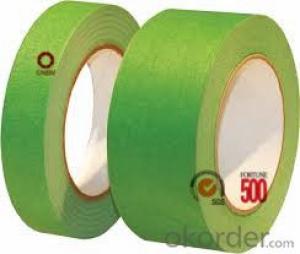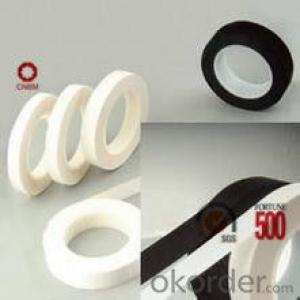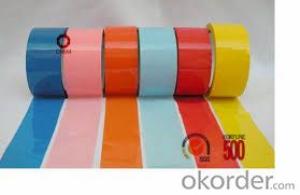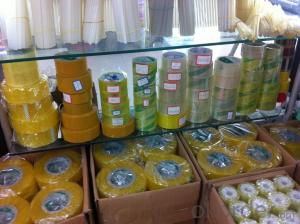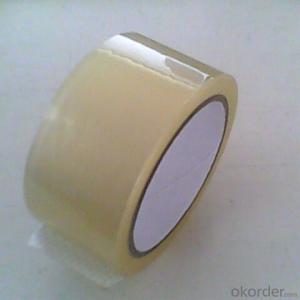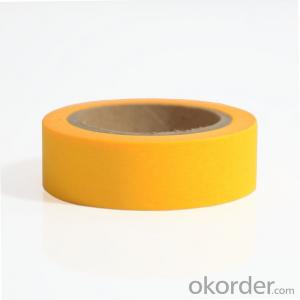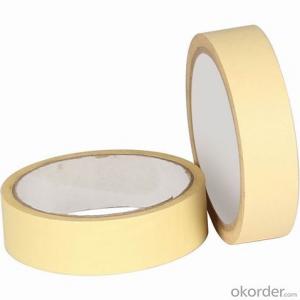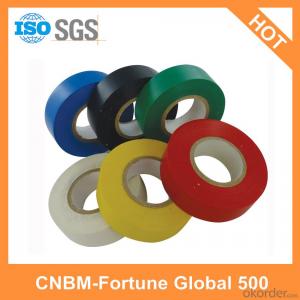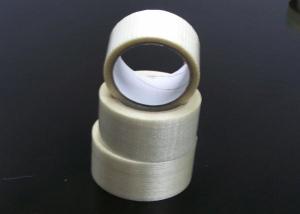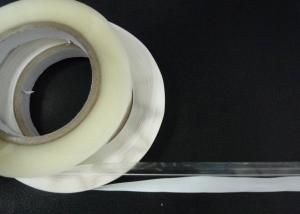Leopard Print Economy Grade Non-Critical Applications Yellow Masking Tape
- Loading Port:
- Shanghai
- Payment Terms:
- TT OR LC
- Min Order Qty:
- 5000 roll
- Supply Capability:
- 10000000 roll/month
OKorder Service Pledge
OKorder Financial Service
You Might Also Like
General Information of Economy Grade non-critical Applications Yellow Masking Tape
1. PACKING:
Core I.D.: 3” (76mm +/- 1)
Jumbo Roll:990mm x 1800m; 80 rolls/20' without pallets
Cut Roll: As per customer’s requirements; fistly several rolls shrink together, then certain quantities into a carton, finally be loaded into container with or without pallets.
2. Application:
Interior paint masking, silk screening, Light duty packaging, bundling, holding, splicing &Tabbing, painting autos, boats, and Electrical industry.
3. Temperature resistance: 60-70°C
4. Colors available: White, light yellow, yellow, blue, black, red, green etc.
5. We could supply OEM service such as core printing with customer's LOGO; round label with design of customers etc.
6. Special requirements will be satisfied after communications
Technical Data of Economy Grade non-critical Applications Yellow Masking Tape
CONSTRUCTION:
Carrier: Crepe Paper
Adhesive: Rubber based adhesive
TYPICAL PHYSICAL PROPERTIES of Economy Grade non-critical Applications Yellow Masking Tape
Total Thickness (adhesives + carrier): 145 +/- 5 micron
Initial Tack (steel ball): 8 #
180 Peel Adhesion (to steel): 6.5 +/- 0.5 N/25mm
Holding Power: 4 hrs
Tensile Strength: 65 +/- 5 N/25mm
Elongation: 10%
Temperature resistance: 60-70°C
Remarks of Economy Grade non-critical Applications Yellow Masking Tape
The data above are typical results and subject to change without notice.
Tolerance: Weight and Thickness: ±10%; Width: ±3mm;
Length: Cut Roll & Log Roll ±0.3m, Jumbo Roll ±0.5%.
The products should be stored at room temperature and be kept away wet and/or heat source.
It is essential, as with all pressure-sensitive tapes, that the surface to which the tape is applied must be clean, dry, and free of grease and oil.
The users should take test and do trial-application on the above products before coming into application so as to witness and ensure suitability for their special purpose and technique.
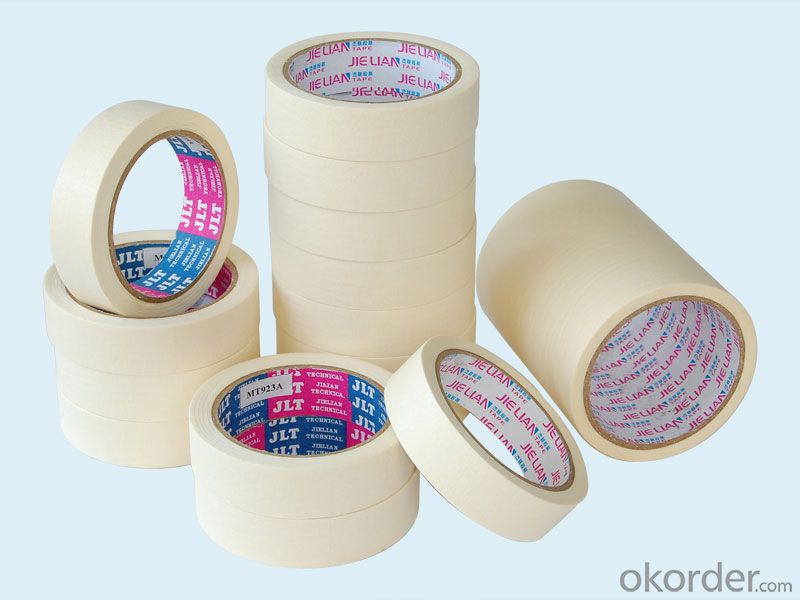


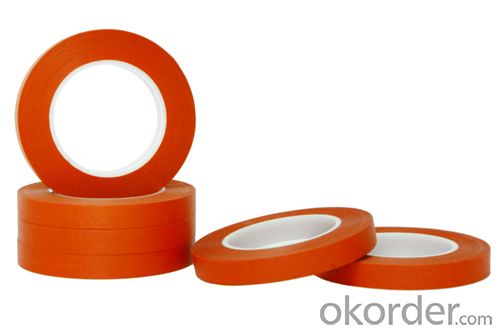
- Q: Can packaging tape be used for sealing packages with automotive parts or accessories?
- Yes, packaging tape can be used for sealing packages with automotive parts or accessories. Packaging tape is designed to securely seal packages, and it can effectively hold together packages containing automotive parts or accessories. It provides a strong adhesive bond, ensuring that the package remains sealed during transportation or storage. Additionally, packaging tape is often resistant to moisture, which is important when shipping automotive parts or accessories that may be sensitive to water damage.
- Q: Does packaging tape come in different lengths for convenience?
- Packaging tape indeed comes in various lengths for ease of use. Different packaging tasks can be accommodated with packaging tape of different lengths. The commonly found lengths for packaging tape are 55 yards (50 meters) and 110 yards (100 meters). These lengths are specifically chosen to address diverse packaging needs and to ensure that there is an ample amount of tape to securely seal multiple packages without any shortage. Furthermore, the availability of different lengths provides the flexibility of selecting the most appropriate quantity of tape for individual packaging requirements, ensuring both convenience and cost-effectiveness.
- Q: How do I remove packaging tape residue?
- To remove packaging tape residue, you can start by applying a small amount of oil or rubbing alcohol to a cloth or sponge and gently rubbing the affected area. This should help loosen the adhesive. Alternatively, you can also try using a mixture of warm water and dish soap, or a commercial adhesive remover. Make sure to test any method on a small, inconspicuous area first to ensure it doesn't damage the surface.
- Q: Can packaging tape be used for sealing medical or pharmaceutical supplies?
- Sealing medical or pharmaceutical supplies with packaging tape is not recommended. These supplies require a higher level of sterility and protection from contamination, which packaging tape may not provide. Instead, specialized medical-grade packaging materials like medical adhesive tapes, tamper-evident seals, or sterile packaging are typically used. These materials are designed specifically for the healthcare industry's stringent requirements, ensuring the supplies' integrity and safety. Using packaging tape for sealing medical or pharmaceutical supplies can compromise their sterility and increase the risk of contamination, which could have serious consequences for patients' health. It is crucial to adhere to industry standards and guidelines for packaging and sealing these supplies to maintain their quality and safety.
- Q: Is packaging tape waterproof?
- Yes, packaging tape is typically waterproof. It is designed to provide a secure seal and protect packages from moisture and other external factors during transit or storage.
- Q: How does packaging tape perform when exposed to chemicals or solvents?
- Packaging tape generally performs well when exposed to chemicals or solvents, but the specific performance may vary depending on the type of tape and the nature of the chemicals or solvents involved. Most packaging tapes are designed to have good resistance to common household chemicals such as cleaning agents, oils, and water-based solvents. They are typically made from materials like polypropylene or PVC, which have excellent chemical resistance properties. This allows the tape to maintain its adhesion and integrity even when exposed to moderate amounts of chemicals or solvents. However, it is important to note that some aggressive chemicals or solvents, such as strong acids or organic solvents, may have a detrimental effect on the performance of packaging tape. These highly corrosive substances can cause the tape to degrade, lose its adhesive properties, or even dissolve completely. To ensure optimal performance, it is recommended to check the specific chemical resistance properties provided by the manufacturer of the packaging tape. They may offer guidance on the suitability of the tape for different types of chemicals or solvents. Additionally, it is advisable to conduct small-scale tests or trials to assess the tape's performance when exposed to specific chemicals or solvents before using it for critical packaging applications. In summary, packaging tape generally performs well when exposed to common household chemicals or solvents. However, its performance may be compromised when exposed to aggressive or corrosive substances. It is important to consult the manufacturer's guidelines and conduct tests, if necessary, to ensure that the tape is suitable for the specific chemical or solvent it will be exposed to.
- Q: Does packaging tape come in different patterns or designs?
- Yes, packaging tape does come in different patterns and designs. While traditional packaging tape is usually plain and transparent, there are also various options available for those who want to add a touch of creativity or personalization to their packages. Some common patterns and designs include bold colors, stripes, polka dots, floral prints, geometric designs, and even custom logos or messages. These decorative tapes can be a fun and unique way to enhance the appearance of your packages and make them stand out. Furthermore, some packaging tape brands offer seasonal or themed designs, allowing you to match your packaging tape to specific occasions or holidays.
- Q: Can packaging tape be used for sealing documents or important papers?
- Packaging tape is not recommended for sealing documents or important papers. It is primarily designed for securing packages, boxes, or cartons during transportation. For important papers, it is advisable to use archival quality materials like document sealing tape, acid-free folders, or document wallets to ensure their protection and longevity.
- Q: Can packaging tape be used for sealing packages for shipping?
- Indeed, packaging tape serves the purpose of sealing packages intended for shipping. With its specialized design, packaging tape effectively secures packages, guaranteeing their integrity throughout the transit process. It establishes a robust and long-lasting connection that can withstand the challenges posed by shipping and handling. Whether you're dispatching small or large packages, packaging tape becomes a vital instrument to guarantee the proper sealing and safeguarding of your items as they embark on their journey.
- Q: What are the different adhesive options available for packaging tape?
- There are several adhesive options available for packaging tape, each with its own unique characteristics and suitability for different applications. 1. Acrylic adhesive: This is the most common type of adhesive used in packaging tape. It offers good adhesion to a wide range of surfaces and has excellent clarity, making it ideal for transparent or light-colored packaging. Acrylic adhesive also provides a long-lasting bond and performs well in both hot and cold temperatures. 2. Hot melt adhesive: This type of adhesive is formulated to provide an instant and strong bond. It has a high initial tack and excellent holding power, making it suitable for heavy-duty applications or sealing boxes with rough or recycled surfaces. Hot melt adhesive is also resistant to aging and performs well in extreme temperatures. 3. Natural rubber adhesive: This adhesive offers excellent adhesion to a variety of surfaces, including recycled materials. It has a high level of tackiness, which ensures a secure bond even on challenging surfaces. Natural rubber adhesive is also resistant to UV light and aging, making it a good choice for long-term storage or outdoor use. 4. Synthetic rubber adhesive: Similar to natural rubber adhesive, synthetic rubber adhesive provides strong adhesion to a wide range of surfaces. It offers good resistance to aging, moisture, and temperature changes, making it suitable for various packaging applications. 5. Solvent-based adhesive: This type of adhesive is known for its high initial tack and excellent bonding strength. It provides a quick bond and performs well on challenging surfaces such as corrugated cardboard or recycled materials. However, solvent-based adhesive may emit strong odors and require additional safety precautions during use. When choosing an adhesive option for packaging tape, it is essential to consider factors such as the type of packaging material, surface conditions, environmental conditions, and specific requirements of the application. Consulting with adhesive manufacturers or suppliers can help determine the most suitable adhesive for your packaging needs.
Send your message to us
Leopard Print Economy Grade Non-Critical Applications Yellow Masking Tape
- Loading Port:
- Shanghai
- Payment Terms:
- TT OR LC
- Min Order Qty:
- 5000 roll
- Supply Capability:
- 10000000 roll/month
OKorder Service Pledge
OKorder Financial Service
Similar products
Hot products
Hot Searches
Related keywords
